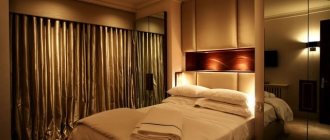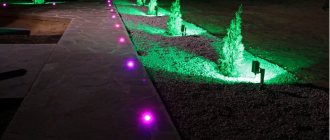Today, lighting has ceased to be just an addition to the interior and has become one of its main components. Now the lighting plan in an apartment design project is prepared along with the furniture, and they think about lamps during the planning process. Designers are looking for a balance between aesthetics and practicality, unusual options, developing different lighting scenarios to make the interior come to life and the owners to feel comfortable and pleasant living in it.
But what if you're already busy renovating and have a trip to the lighting store coming up? We asked interior designer Ekaterina Belyaeva to give us some professional advice so that no one makes annoying mistakes. Everyone should get the lighting of their dreams!
Ekaterina Belyaeva, designer of ReRooms
She graduated from the Tula Polytechnic Institute and has been working as an interior designer since 2012. Owns a workshop of design and designer interior items, and runs a blog. Creative credo: design is not fashion, but good taste!
How to install a track system
Another undeniable advantage of bus lighting is ease of installation.
If you are doing repairs from scratch, then everything is simple: the voltage output is thrown and the bus power is connected to it. If you decide to replace the existing ceiling light in the room, you will need to take a few simple steps to replace it with a busbar lighting system. First you need to remove the old lamp. Then attach the track to the ceiling (usually with self-tapping screws, or plumb bobs and hanging cables). After this, you need to connect the installed system to the power supply. It's best to hire a qualified electrician if you're not sure you can do it. Now all that remains is to install the lights on the bus in the right places and the bus lighting system is ready for use. You will be able to move and turn on the lamps exactly the way you want, and create a lighting scheme that is comfortable for you. Below, using the example of the Paulmann U-rail track system, you can familiarize yourself with the stages of installation of track lights. In conclusion, we note that you should not worry about the number of track lights on the bus; if it seems to you that there is not enough light, you can always buy and install additional lights. After all, this is precisely the beauty of track lighting systems - its excellent and laconic appearance, applicability in any interior, mobility, functionality, and ease of installation.
Updated 15.01.2020.
If the material is copied in full or in part, a link to the source is required, a specialized center for track lighting systems.
Follow the style
Lamps should still fit into the interior and decorate it, especially today, when there are so many designer chandeliers in stores that look like sculptures. There are manufacturers who specialize only in Art Deco style lighting, for example, or who only make children's lamps. It's always best to go straight to an expert in the field you need. But remember that the number of decorative details, material and color of the lamp will affect the quantity and quality of light, so try to maintain a balance.
Photo by ReRooms
One color temperature
In a good, complete, complete interior, the light environment should be monotonous.
This means that for lighting it is necessary to use lamps with the same color temperature.
A rare exception may be the case when you want to emphasize the texture of some materials, or highlight individual interior items.
Lighting scenarios
Lamps are selected and placed based on how the room will be used. There are no universal solutions. The scenarios depend on the functional areas, lifestyle and requirements of the apartment owners.
- In the living room they usually relax, watch TV, and read. As a rule, bright general light is not needed here: it invigorates, not relaxes. But still, the lighting should be solemn: holidays are celebrated in this room and guests are received. Therefore, as a rule, it is decorated more elegantly than other rooms. Soft general lighting will be provided by built-in or pendant lamps. Decorative items are also needed: they will decorate the interior and create the necessary mood.
- In the bedroom they relax, read, watch TV, and change clothes. This is an intimate part of the apartment; comfort and harmony in the interior are important here. You can place dim lamps near the bed, spots or spotlights near the closet, and illuminate the mirrors. Bright ambient light helps you wake up in the morning, so it's worth adding that too. Decorative lighting - optional.
- The nursery should have a lot of light. General lighting is required, and working lighting is required in areas for relaxation, study and play. Decorative - optional: garlands and night lights will make the room more comfortable.
- The kitchen illuminates the work surface and dining area. General light is not necessary, especially if the kitchen is small: built-in lamps along the furniture, lighting above the countertop and a pendant or wall lamp above the table are sufficient.
- In the hallway, the lighting should be bright: there are rarely windows here, so you need to compensate for the lack of sunlight. Built-in lamps are chosen as general lighting. They can be supplemented with a chandelier in the center of the ceiling if the room is large. Working lighting will also be needed: sconces or lamps near the mirror, cabinet lighting.
- In the bathroom you need general lighting and directional lighting (near the mirror). Sometimes built-in shelving is illuminated for beauty.
- The toilet only needs general lighting. Directional is unlikely to be useful, decorative is optional.
Thoughtful scenarios help determine the number and location of lamps. They are marked on the plan of the future interior immediately after the furniture: this way each light bulb will find its place.
Let's look at lighting scenarios using the example of a studio apartment. There is one room here, but it is divided into zones: bedroom, living room, kitchen, dining room, office. The apartment also has a dressing room, hallway and bathroom.
The role of general lighting was played by a track structure on the ceiling in the center of the room. The lamps can be directed where more light is needed - for example, at the workplace.
Track lighting around the perimeter and pendant lamp behind the sofa / Project author: Tatyana Vasilyeva
Each zone has directional lighting: in the kitchen there is lighting above the countertop, in the bedroom there is a sconce, there are pendant lights above the dining table and sofa, and a floor lamp at the desk. They are included as needed.
Lighting above the kitchen countertop, lamp above the dining table / Project author: Tatyana Vasilyeva
Decorative lamps were provided near the bed. They provide soft, dim lighting. Convenient if you want to watch TV before bed.
We decided to place sconces and decorative lighting in the bedroom area / Project author: Tatyana Vasilyeva
Only general lighting was left in the hallway and dressing room. These are small rooms where you don't need too much light. In the bathroom we decided to assemble a multi-level ceiling and install lamps in it. A mirror with built-in lighting was provided.
Three-level ceiling in the bathroom / Project author: Tatyana Vasilyeva
It turns out that for every action of the apartment owners there is a lighting scenario: you can read in bed, have dinner in the cozy light of a lamp, watch TV comfortably, apply makeup or shave in front of the mirror in the bathroom. The work areas are sufficiently lit to make them comfortable to use. The light can be adjusted to suit your mood: bright for entertaining guests, dim for a relaxing environment.
Dressing table
This type of furniture is often present in bedrooms - this is a place of privacy and transformation for every woman. A sconce can be a beautiful addition to an elegant table, because this particular light source is distinguished by its variety of designs. On large models of tables, manufacturers specifically provide places for attaching light sources on both sides of the mirror at a level of 40-50 cm from the tabletop, which can be supplemented with lighting. In this case, it is better to select all devices in one design.
Small dressing tables provide for independent arrangement of appliances installed nearby. To provide enough light to create beauty, it is better to purchase sconces with rotating shades and install them 15-20 cm above the head of a sitting person.
Selection of lamps and fixtures
Properly organized room lighting will allow you to hide flaws, highlight advantages, change proportions, and zone it. To do this, it is important to choose lamps and fixtures. But lighting elements are especially important, on which the degree of illumination, light power, etc. depend.
Optimal light bulbs for everyday use
The following lamps are used for lighting:
- Incandescent lamps are comfortable for vision, but they heat up too much, have a short service life, and consume a lot of electricity.
- Halogen light bulbs use less electricity than regular bulbs, but they get very hot. They emit directional light, so they are often used for zonal lighting.
- Fluorescent light sources barely heat up, they are economical, and have a wide spectral range. However, they emit an unpleasant hum and contain mercury vapor.
- LED lamps are strong, safe, durable, energy efficient, and their range is wide. However, they are expensive, and many fakes have appeared on the market, so you should choose proven devices src=»https://svetilnik.info/wp-content/uploads/2019/03/Led-lampy.png» class=»aligncenter» width ="497″ height="311″[/img]
Fluorescent and LED lamps are more often used for lighting.
Optical fibers and duralight tapes based on diodes are used for additional lighting to highlight interior elements.
How to select lamps: main criteria
When choosing lighting equipment, you should consider the following rules:
- Buy a product from a trusted manufacturer.
- The lamp must match the design of the room.
- Decide on the color and material of the device. For example, a chandelier in calm tones with glass or fabric shades is more suitable for a classic interior.
- Choose a device based on the size of the room.
- Decide on the function of the device: decoration, functional lighting.
If it is difficult for you to choose a lighting device on your own, then consult a specialist.
Don't neglect the technical part
When choosing lamps, you need to pay attention to their characteristics, especially the lighting area. In addition, in stores, lamps are often already connected so that you can see how much light they actually provide and how it is distributed. This is important so that you get not just a beautiful, but also a practical chandelier that will perform its tasks. Design alone is not enough! Also pay attention to what kind of lamps the lamp is designed for: the softest and most practical are LEDs.
Photo by ReRooms
Modern trends
Modern lighting is designed to increase the level of comfort, simplify everyday tasks and make the home safer. To do this, you can organize night lighting in the apartment, install motion sensors that automatically turn on the lights, and use wireless lamps. These devices are easy to install, comfortable, functional and help reduce electricity costs.
Night lighting in the apartment
Night lighting can be used to complement the main lighting; it will help you move around the apartment unhindered at night. For this purpose, lighting devices with motion sensors, luminous baseboards, panels, and products built into walls or floors are used.
Motion sensors
Modern apartments use indicators that react to human presence and turn on the lights. Based on their mechanism of action, the following sensors are distinguished:
- Infrared – recognizes human thermal radiation and the light automatically turns on.
- Ultrasonic and microwave - have a similar mechanism of action, but are triggered using sound waves.
Attention! The sensors can be installed in the corridor, hallway, kitchen (under the cabinet), bathroom, and also on the stairs. The only place where it is not recommended to place the device is the bedroom.
Wireless lamps
Wireless devices are used as night lighting, and they are also indispensable for illuminating dark places in the apartment, to which it is difficult to route wires. Depending on the installation method, there are ceiling, wall, and tabletop devices.
They are compact, lightweight, so they can be used almost anywhere. There is a wide range of wireless lamps that differ in design, design, and type of light.
Conclusion
Any advice on lighting a room, without a detailed floor plan, furniture arrangement and color design, is doomed to failure. Therefore, in our article we only outlined the basic requirements and focused your attention on important aspects.
At the same time, if you draw up a floor plan, right down to arranging books on shelves, then the most correct and convenient lighting system will be clearly visible. The main thing is not to overdo it with decorative elements. After all, everything in lighting should be in moderation.
Wall lighting
Never forget about lighting vertical surfaces. About 80% of our attention in rooms is focused on the walls.
When we move, communicate with each other, or simply sit in a chair, our gaze is always directed to vertical surfaces, and not to the ceiling.
The ceiling space takes up only 15% of attention, and the floor gets only 5%.
Therefore, if you want to get a comfortable room where it will be pleasant to be, do not forget about lighting the walls. In large living rooms, the concentration of lamps around the perimeter should be done based on this rule.
Model space with light
With the help of light you can visually change the space of a room. This is especially important if you have narrow walls or low ceilings. Disadvantages can be visually eliminated if you know where to direct the light. For example, in a narrow corridor, illuminate one wall using a track light on the ceiling. There will be a feeling of the depth of space: one wall will go into the distance, and the second will seem to completely dissolve into thin air. And there are a lot of similar tricks - that’s why you need the help of a designer!
To summarize, I would like to note once again that the lighting plan in a design project is one of the most important components. In order for the repair team to do everything correctly and not have to spend money on unnecessary alterations, it is better to prepare a project that takes into account all the details regarding electrical and lighting. Below are ready-made lighting plans and corresponding visualizations from design projects developed by ReRooms.
Photo by ReRooms
Think about management
It is also often forgotten when choosing flooring and wall color, but it is imperative to remember! Otherwise, you will have to walk across the entire apartment to turn on the light in the hallway, and put up with too much bright lighting in a small area. Pass-through switches and dimmers are very helpful in controlling light even in small apartments.
Photo by ReRooms
In addition to the basic source
The traditional option is when a chandelier hangs in the middle of the ceiling and sconces are installed near the bed. The basic source provides enough light at night, and the sleeping area is complemented by devices that create enough light for reading. In this case, you need to fix the sconce at arm's length, 50-70 cm from the bed, above the bedside table or a small shelf installed nearby. The installation height should be no more than 1.6 m from the floor, and the luminous flux should go down.
An option for replacing sconces is hanging or built-in spots that allow you to change the direction and intensity of the light.











